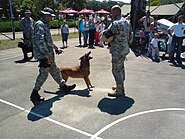| Special Anti-terrorist Unit | |
|---|---|
 SAJ emblem | |
| Active | 1978 - Present |
| Country |
|
| Branch | MUP |
| Type | Special forces |
| Role | Domestic anti-Terrorism and Law Enforcement |
| Size | 264[1] |
| Garrison/HQ | Batajnica |
| Nickname(s) | SAJ |
| Commanders | |
| Current commander | Lt. Colonel Spasoje Vulević |
The Special Anti-terrorist Unit (Serbian language: Специјална Антитерористичка Јединица, CAJ / Specijalna Antiteroristička Jedinica, SAJ) is a special operations and tactical unit of the Serbian Police.
History[]
The SAJ was established in the former Yugoslavia, due to the increasing phenomenon of terrorism in Europe that was occurring at the time from such groups as: IRA, ETA, Red Army Faction and the Red Brigades. The unit was founded on, 13 May 1978 [2]
The detachment for special effects in the Federal Secretariat of Internal Affairs - SSUP, and was appointed the first commander Franz Kos. After seven months since the founding of the federal unit for special effects, a decision was taken to establish on republic and provincial levels a unit with the same purpose. The Unit for Anti-terrorist effects (Jedinica za antiteroristička dejstva - JATD) in the Republic Secretariat of Internal Affairs - RSUP of SR Serbia was established in Novi Beograd on December 18, 1978.
The first commander of unit was Miloš Bujenović. Main tasks of new formed unit were classical fight against terrorists, to prevent aircraft hijacking, release of hostages, the fight against organized crime and similar action of the high-risk in urban areas. In 1983 units base was relocated to the Belgrade airport and renamed in to Units for special effects (Jedinica za specijalan dejstva RSUP). In 1991 unit was again renamed in to Special units (Specijalne jedinice), and its new commander was Radovan Stojičić. On June 1, 1992, Command of Special Anti-terrorist units (Komanda SAJ) was established, with Živko Trajković as commander. It consisted from Belgrade SAJ, under command of Zoran Simović Novi Sad SAJ, under command of Branko Ćuričić.[3]
SAJ team descend from Bell 212 helicopter
Publicly known operations[]
As well as killings of Kosovo Albanians, SAJ was also involved in "sanitation";[4] bodies were moved to mass graves in Serbia, in an attempt to conceal ethnic cleansing. The Batajnica mass graves, on a SAJ firing range,[5] are estimated to contain between 700[6] and a thousand[7] victims. Dead bodies were brought to the site by trucks from Kosovo; most were incinerated before burial.[8] After the war, SAJ restricted investigators' access to the firing range, and continued live-firing exercises whilst forensic teams tried to investigate the massacre.[9]
- 1989 - On 27 February 1989 when, during the 1989 Kosovo miners' strike, the most persistent "Stari Trg" 50 strikers barricade on the horizon ninth, (850 m underground). The campaign was launched at midnight, and because they lift a disability, special forces have descended through the fire holes and surprised strikers.
- 1997 - action against hijacker in Smederevo.
- 1998 - counter-terrorist operations against the Kosovo Liberation Army (KLA); attack on Prekaz and killing of 54 people including Adem Jashari.
- 1999 - Račak massacre, involving the killing of Kosovo Albanian civilians[10] and nine members of the Kosovo Liberation Army.[11]
- 1999 - Podujevo massacre. Members of the "Scorpions", attached to SAJ, killed 14 women and children.[12]
- 2003 - "Operation Sablja" Arresting members of the Zemun organized crime gang.
- 2007 - Arresting the mass murder in the Jabukovac killings.
- 2010 - First Belgrade Pride Parade security
Structure[]

SAJ officer
SAJ has four teams: "A", "B", "C" and "D". "Striking force" are teams of "A" and "B" which solve complicated hostage situation, quickly enters into kidnapped airplanes, buses, breaking into barricaded buildings, arresting a dangerous person with guns and criminals. Team C is a specialist and make it: sniper group, underwater diving group, group guide service dogs, the group of engineer for explosive land mines and group for biological and chemical agents (BHS). In executing task A, B and C have coordination team work, as a single entity, a team in which everyone has clearly defined tasks. Team D a protect important persons and objects which is an exposed threats of terrorist attack. Logistical support provided by medical group, the group for the construction and testing of weapons and ammunition, technical and emergency services.[13]
- Team A - Assault
- Team B - Assault
- Team C - Logistics
- Team D - Support
Equipment[]
Gallery[]
References[]
- ↑ "Novi odred Žandarmerije sličan JSO" (in Serbian). B92. 24 January 2012. http://www.b92.net/info/vesti/index.php?yyyy=2012&mm=01&dd=24&nav_category=12&nav_id=576813. Retrieved 3 August 2013.
- ↑ Naša elita sa tradicijom
- ↑ Специјална Антитерористичка Јединица(Serbian)
- ↑ http://www.theguardian.com/world/2010/may/10/kosovo-albanian-mass-grave-serbia
- ↑ http://www.b92.net/eng/news/crimes.php?yyyy=2007&mm=02&dd=25&nav_id=39816
- ↑ http://www.ic-mp.org/wp-content/uploads/2008/02/icmp-fsd-16-04-2-doc.pdf
- ↑ http://www.theguardian.com/world/2010/may/10/kosovo-albanian-mass-grave-serbia
- ↑ http://www.vreme.com/cms/view.php?id=325025
- ↑ http://www.academia.edu/831207/Fresh_scars_on_the_body_of_archaeology_excavating_mass-graves_at_Batajnica_Serbia
- ↑ Massacre that started long haul to justice
- ↑ Judah, Tim (2000). Kosovo: War and Revenge. Yale University Press. p. 193. ISBN 978-0-300-09725-2. http://books.google.ca/books?id=sVf1na3FN_UC&printsec=frontcover.
- ↑ http://www.icty.org/x/cases/djordjevic/tjug/en/110223_djordjevic_judgt_en.pdf
- ↑ Komandosi uvek spremni za zestoku akciju
- ↑ Moderan "gradski" karabin
External links[]
| Wikimedia Commons has media related to SAJ (Special Anti-terrorist Unit). |
The original article can be found at Special Anti-Terrorist Unit (Serbia) and the edit history here.







